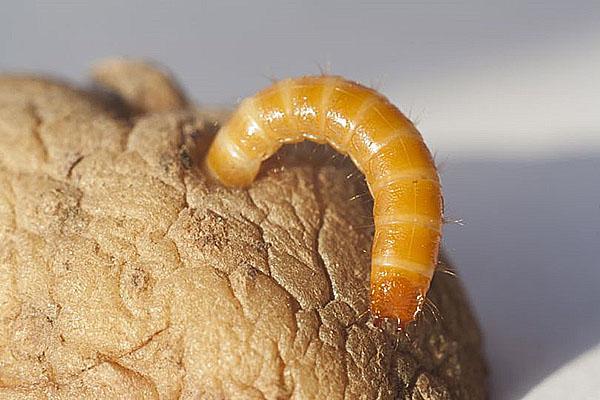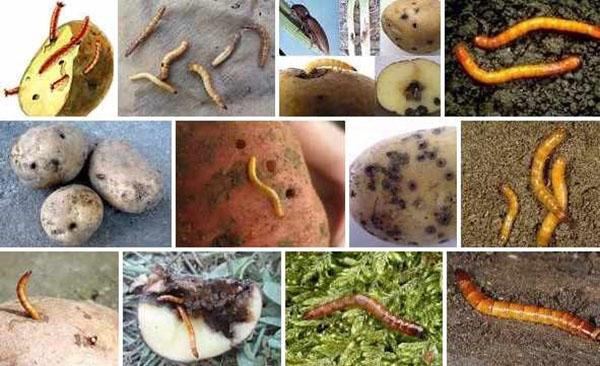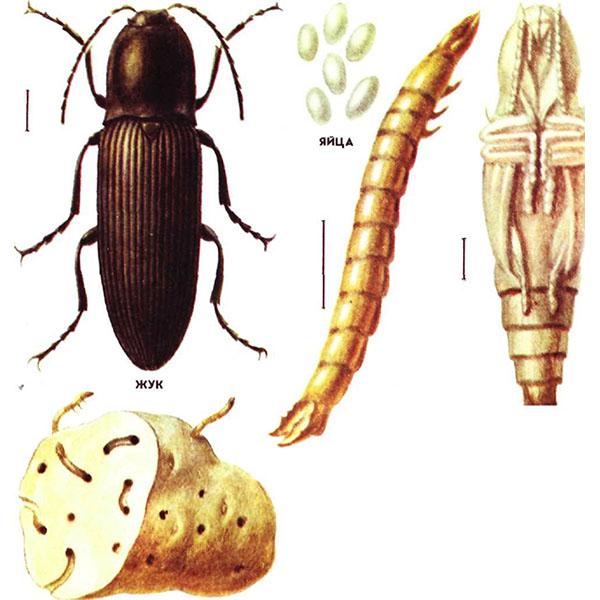Fighting the wireworm: the gardener's arsenal of natural and chemical "weapons"
 What frost, what heat, and the larva of the click beetle survives in any conditions, successfully eating potatoes in the garden. The fight against wireworms can include both agrotechnical measures and the use of chemical or folk remedies. Before you learn more about these methods, you need to get to know the "omnipresent" pest.
What frost, what heat, and the larva of the click beetle survives in any conditions, successfully eating potatoes in the garden. The fight against wireworms can include both agrotechnical measures and the use of chemical or folk remedies. Before you learn more about these methods, you need to get to know the "omnipresent" pest.
Wireworm: external features and diet


Several signs will help to recognize the pest:
- body length - 10-40 mm;
- shade - copper, brown or yellow;
- tough skin that is difficult to crush;
- habitat - in the soil at a depth of 3-5 cm.
Insects begin to pupate in the fourth year and this often happens in July. After 3 weeks, pupae develop into adult click beetles. For this reason, after harvesting, it is recommended to completely remove the tops and tubers from the site in order to deprive the pests of food.
Depending on what the wireworms damage, their number will grow in the garden.
Typically, plantings suffer from the invasion of "voracious larvae":
- potatoes;
- carrots;
- salad;
- corn;
- sunflower;
- tobacco;
- alfalfa;
- melons and gourds (melons, watermelons).
 They become especially active during drought periods. The larvae are intensely looking for swollen seeds, as well as seedlings in order to feast on juicy shoots and stems. Therefore, many varieties of grain and ornamental plants are excellent sources of moisture and nutrition for them. In addition, they can infect the roots of fruit trees. However, during the rainy seasons, the parasites are practically harmless.
They become especially active during drought periods. The larvae are intensely looking for swollen seeds, as well as seedlings in order to feast on juicy shoots and stems. Therefore, many varieties of grain and ornamental plants are excellent sources of moisture and nutrition for them. In addition, they can infect the roots of fruit trees. However, during the rainy seasons, the parasites are practically harmless.
Need to know where the wireworm hibernates? Often, parasites burrow into the soil to a depth of 10-15 cm, but in severe frosts, they sink into the ground by 50-60 cm.
Wireworm control: the basics of farming
 Prevention is the most relevant and less costly way to protect a site from pests. In this regard, gardeners in the fall or spring sow their land with siderates.
Prevention is the most relevant and less costly way to protect a site from pests. In this regard, gardeners in the fall or spring sow their land with siderates.
As plant repellents, they use:
- mustard;
- legumes;
- phacelia;
- peas.
 When the seedlings reach 10 cm and have not yet had time to release the flower stalks, they are mown and then embedded in the ground. In addition, it is necessary to carry out seasonal digging of the garden. In late autumn, before the onset of frost, the soil is plowed deep enough (up to 20 cm). As a result, the larvae find themselves on the surface and die from the harsh climate.
When the seedlings reach 10 cm and have not yet had time to release the flower stalks, they are mown and then embedded in the ground. In addition, it is necessary to carry out seasonal digging of the garden. In late autumn, before the onset of frost, the soil is plowed deep enough (up to 20 cm). As a result, the larvae find themselves on the surface and die from the harsh climate.
The bait is also corn or leafy lettuce planted between rows. As soon as their shoots are extended, the shoots are pulled out with the rhizome along with a whole "horde" of parasites.
Since wireworms are very tenacious, the measures to combat them must be tough. For this, special traps are prepared for click beetle insects.
For 1 hundred square meters you will need:
- choose 10 cans;
- place them at the same distance;
- fill with young potato leaves, beets or carrots.
 Instead of containers, you can simply make holes in the ground (10-15 cm) and put pieces of root vegetables or dried tops / grass in them. After 3-4 days, the trap must be replaced. It is advisable to carry out this procedure in April or May, when the parasites have not yet had time to completely wake up from hibernation.
Instead of containers, you can simply make holes in the ground (10-15 cm) and put pieces of root vegetables or dried tops / grass in them. After 3-4 days, the trap must be replaced. It is advisable to carry out this procedure in April or May, when the parasites have not yet had time to completely wake up from hibernation.
 Some gardeners are fighting wireworms with ash. This material is used to reduce the acidity of the soil. A sufficient amount of ash is either sprinkled on the top layer of the soil, or added to each hole when planting potatoes. In addition, a unique fertilizer is mixed with eggshells or chalk.
Some gardeners are fighting wireworms with ash. This material is used to reduce the acidity of the soil. A sufficient amount of ash is either sprinkled on the top layer of the soil, or added to each hole when planting potatoes. In addition, a unique fertilizer is mixed with eggshells or chalk.
Wireworm lime is used successfully. It is laid out in small quantities in the aisles or poured into the hole.
Wireworm control methods: folk potions
 In nature, there are insecticide plants. They can be used to prepare an effective remedy for the destruction of "intruders".
In nature, there are insecticide plants. They can be used to prepare an effective remedy for the destruction of "intruders".
To do this, grind:
- nettle leaves and stalks (0.5 kg);
- dandelions (200 g);
- mother-and-stepmother greens (200 g);
- celandine (100 g).
The ingredients are poured into a bucket of warm water (10 l) and insisted for up to 4 days. The beds are watered with infusion only 3 times a season with an interval of 7 days. Among other things, the planting is mulched with coniferous litter. Agronomists recommend using needles or branches from a young pine tree. This shelter is harvested 2-3 days before harvest.
How to deal with a wireworm in a greenhouse? Miniature beds are disinfected with a solution of potassium permanganate (for 1 m² you need 2 liters of solution). In 10 liters of liquid, 2-5 g of powder are diluted.
Onion peel from wireworm is used as a prophylactic agent. On its basis, a decoction is prepared, in which the roots are soaked before planting. A large handful of dry husk is also added to the hole.
At the same time, some farmers practice digging a vegetable garden with it in the fall. Then, in the spring, they spill the plot, but only along the perimeter, with a concentrated solution of sodium chloride. According to gardeners, after the procedure, pests no longer appear on their territory. However, these remedies do not always help to get rid of the wireworm, so there are other methods of dealing with it. Insecticides are often the most effective.
Wireworm Fighting: Chemistry Lesson
 The safest remedy for the larvae of the click beetle is the introduction of fertilizing based on ammonium or ammonia water. It is worth knowing that these compounds evaporate quickly, so the solution should be immediately embedded in the soil. Planting treatment with wireworm preparations is carried out only in exceptional cases when all other methods do not help.
The safest remedy for the larvae of the click beetle is the introduction of fertilizing based on ammonium or ammonia water. It is worth knowing that these compounds evaporate quickly, so the solution should be immediately embedded in the soil. Planting treatment with wireworm preparations is carried out only in exceptional cases when all other methods do not help.
Such compositions include:
- "Bazudin" (hazard class 3). The contents of the sachet (30 g) are thoroughly mixed with sand or sawdust, which fill liter container, and add 1 tsp into the well. The action of the pesticide begins in the first 24 hours, and the insecticide itself retains its properties for 6 weeks. According to the instructions, Bazudin is used against wireworms, cabbage flies and other soil-dwelling pests.

- Provotox. Belongs to the class of organophosphate insecticides of the 3rd degree of danger. Its consumption rate is 40 g (package) per 10 m², and it is not recommended to mix the drug with other substances. Provotox from the wireworm is used with the calculation of 7-9 granules for each planting hole.

- "Prestige". To prepare a working solution, you will need to dilute 20 ml of the pesticide in 200 ml of liquid (either 150 ml - in 1.5 / 3 l, or 60 ml - in 0.6 l). The suspension is thoroughly sprayed with potato seed tubers (20 kg), and then thoroughly mixed.

- "Initiative". This is another insecticide for the wireworm and cabbage fly. A container (with a volume of 1 l) is ¾ filled with coarse granular sand / sawdust and 30 g of the preparation is poured. After mixing the mixture well, add 2 tsp into each well.

Chemical treatment is carried out 40-60 days before harvesting.It is recommended to start gardening only 7 days after etching.
Using these drugs, wireworm control will be successful. It will run quickly and with the best results if you follow the instructions.